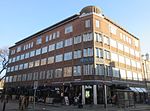The Lanes

The Lanes are a collection of narrow lanes in Brighton, in the city of Brighton and Hove famous for their small shops (including several antique shops) and narrow alleyways. The Lanes are commonly taken to be bounded by North Street to the north, Ship Street to the west and Prince Albert Street and the north side of Bartholomew Square to the south. The eastern boundary is less well-defined and can be considered either East Street or Market Street. Meeting House Lane is one of the wider lanes which meets with the busy shopping road of North Street and eventually winds around to Market Street. The north end of Meeting House Lane meets North Street a few yards down the road from the southern end of North Laine which is not part of The Lanes.
Excerpt from the Wikipedia article The Lanes (License: CC BY-SA 3.0, Authors, Images).The Lanes
Bartholomews Avenue, Brighton Queen's Park
Geographical coordinates (GPS) Address Nearby Places Show on map
Geographical coordinates (GPS)
| Latitude | Longitude |
|---|---|
| N 50.821 ° | E -0.14 ° |
Address
Bartholomews Avenue
BN1 1HG Brighton, Queen's Park
England, United Kingdom
Open on Google Maps









